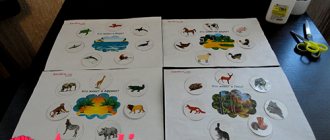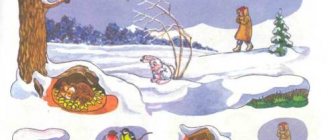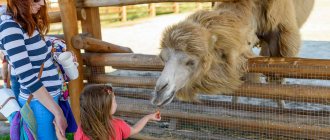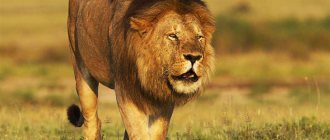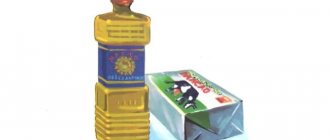The list of wild and domestic animals provides an overall picture of biological qualifications according to the following criteria:
- habitat;
- food type.
Wild animals live in natural conditions in various ecological niches. Certain species, domesticated by humans, became domesticated in primitive society, and as a result of breeding work, new breeds appeared that changed the original species beyond recognition.
Classification by habitat
Weather conditions, food sources, and terrain features determine the habitat of certain animal species. For example, the territory of the Russian Federation is inhabited by a variety of wild animals, the list of which is represented by 300 species of mammals. Based on their habitat, they are conditionally united into the following groups:
- bodies of water (representatives: muskrat, beaver, muskrat, manatee);
- desert, semi-desert (for example, hare, shrew, gerbil, ground squirrel, jerboa, vole, corsac, hedgehog) - the animal body is adapted to fluctuations in daily and annual temperatures;
- steppe, forest-steppe (representatives: bobak, jerboa, vole, steppe moth, saiga, ferret, hare);
- broad-leaved, deciduous, mixed forests (wolf, wild boar, deer, lynx, badger, etc.);
- taiga - among the inhabitants, a large group consists of predators (bear, lynx, wolverine), fur animals (hare, ermine, squirrel), ungulates (wapiti, roe deer, elk, deer);
- tundra, forest-tundra - most animals are covered with thick, light-colored fur;
- Far North, Arctic - land animals are represented by ten species, cetaceans - 14, pinnipeds - 9; among them: polar bear, harp seal, ringed seal, walrus, arctic fox, reindeer, bearded seal.
Hare
In fairy tales, we are used to seeing the hare as cowardly and stupid. In fact, this is an intelligent and nimble animal that can throw both a fox and a person off the scent. Perhaps the hare is considered cowardly because he often hides in the grass or bushes, catching a sound that alerts him with his large ears, and with quick long jumps runs away from enemies who still managed to detect him. Sometimes the hare suddenly returns in its own tracks and jumps far to the side - so there are more tracks, and it is no longer clear where the animal went.
The hare's eyes are located on the sides of its head, which is why it is called “slanty”. But thanks to this feature, he can see what is happening not only in front of him, but to the side and even behind.
The snowshoe hare turns white in the winter to blend in color with the snow. The brown hare, which lives in the fields and steppes, is gray all year round, and by winter it also brightens, but not so significantly.
The main enemies of hares are foxes, wolves and birds of prey. During the day, in the light, the hare hides from them alone, and comes out to eat in the evening or before dawn. Hares feed on grass, branches, plants, and in winter, tree bark. Crops from gardens are often stolen.
Hares have sharp teeth and long, sharp claws. Contrary to stereotypes, it happens that wild hares kill foxes, and not vice versa. Sometimes a hare can even rush at a person, but only for self-defense. If you don't offend the animal, it will most likely simply hide when it sees you.
The little hares feed on their mother's rich milk, but if she suddenly leaves on business, then they feed on the milk of another hare. They grow quickly.
Carnivores
Carnivores are grouped into 7 groups:
- bears - 8 species;
- canids - 35 species;
- felines – 41 species;
- Viverridae (nocturnal and tree-dwelling) – 35 species;
- hyenas – 4 species;
- mustelids – 56 species;
- raccoons.
The source of energy for them is food of animal origin: insects, vertebrates and invertebrates. Distinctive features of carnivores: sharp claws and teeth (sometimes fangs), endurance in running, acute vision, excellent hearing, developed sense of smell.
Lynx
Meeting this large yellow-red forest “cat” with the famous “tassels” on its ears is a great success. Even hunters encounter lynx extremely rarely. At the same time, it does not pose a danger to humans, unless it is suddenly infected with rabies.
The lynx is flexible, dexterous and strong, and can climb trees and swim well. And deep snow is not a hindrance for her - because of her strong, furry paws. The lynx is also cunning - sometimes it checks the traps and traps of hunters before they themselves and drags away other people's prey. Sometimes it can wait for hours for a prey (hare, deer, roe deer, bird) in ambush, then quietly and unnoticed to sneak up and jump on it. If you can’t catch it the first time, the lynx can hunt for the same animal all day long. By the way, when entering the countryside, the lynx also hunts cats - almost their own kind.
Lynxes prefer to settle in secluded places - for example, in holes under trees. They are not shy about occupying other people's holes.
Lynx cubs are furry and blind for the first few days. By the way, both parents raise lynx cubs, and this is a rather rare case in the animal environment.
Herbivores
A special group consists of herbivorous wild animals. The list of their food sources includes roots, grass, fruits, vegetables, bark and tree branches.
Artiodactyls are classified into a separate group, among them: deer, roe deer, bison, zebra, llama, elk and others.
Distinctive features of ungulates are:
- well-developed jaws capable of grinding hard stems and leaves of plants;
- strong muscular legs that protect you from predators;
- hooves that provide protection to the legs while traveling over hard (including rocky) terrain and help defend against the enemy.
The largest herbivore is the elephant, among the smallest are the field mouse and hamster. Of particular interest is the kangaroo, a marsupial herbivore with highly developed hind legs and short front legs.
Wolf
The wolf that lives in the forest looks like a shepherd dog - not surprising, because it is from the wolf that all dogs trace their ancestry. But you can still distinguish a wolf: it is larger than a dog and never curls its tail into a ring. And he doesn’t bark, but howls or growls. His fur is gray or reddish, thick and warm.
In fairy tales, the wolf is considered a treacherous, formidable and evil animal. He received such “fame” because he is a predator - he feeds on the flesh of animals caught during hunting: roe deer, hares, foxes, badgers, mice, marmots, wild geese and others. Sometimes wolves even kill their own kind.
Berries, fruits and mushrooms are also included in the wolf's diet. Sometimes wolves steal watermelons and melons from farms - all because these animals are often thirsty: they have a high need for water.
Wolves hunt mainly in packs - and not where they live. Even if the wolf's den is located near a farm or village, the animals will not give themselves away, because they will hunt far away - perhaps kilometers - from the “place of residence.”
When you see a wolf in the forest, it is better to retreat quietly, without looking him in the eye, or leave altogether. At the same time, it should not be considered a “bad” animal - it is a dexterous, fast, smart and strong animal. Wolves are also good parents: she-wolves feed their cubs with milk and always protect them from danger. Wolf cubs are born deaf and blind, so at first they are completely defenseless. When they grow up a little, their parents bring them live prey - not only for food, but for play and passive “hunting”.
Omnivores
Wild omnivores represent a separate group. Their list includes such representatives of the fauna as the bear (with the exception of the polar bear, which eats only meat), hedgehog, raccoon, mouse, squirrel, pig (boar), chipmunk and others. All these animals are capable of obtaining nutrients and vital energy from foods of both animal and plant origin. The ability to easily change their diet gives them the opportunity to adapt to different nutritional conditions and adapt to different ecological niches.
Boar
Powerful and strong fanged boars, the ancestors of pigs, look menacing and are therefore considered very dangerous. In fact, a healthy boar, like many other animals, can attack a person only if there is a need to defend itself or protect its cubs. But wounded and sick boars are really aggressive and unpredictable. Be that as it may, you can’t run away from them, just like you can’t come closer, look into their eyes, or turn your back. When meeting a wild boar, you should behave calmly. But, most likely, the meeting will not happen - the boar will hear you from afar and leave on its own.
This animal runs quickly - the structure of its hooves allows it to overcome even swamps without getting bogged down - and swims across any rivers. But it is difficult for a wild boar to move in deep snow. At the same time, he does not freeze in cold weather - by winter he develops a thick undercoat and accumulates fat.
Wild boars live in small groups. They eat hazelnuts, seeds, acorns, plant tubers, and enjoy mushrooms, berries, apples and pears. Sometimes they dig up potatoes or turnips from summer cottages. Piglets are given birth in a den hidden by moss and branches. On the backs of the babies there are light stripes, because of which the cubs are not visible among dense thickets and in bright light, as well as in the shade.
Like pigs, wild boars love to bathe in mud - this is how they escape the heat and get rid of insects clinging to their coarse fur.
Enviroment protection
To attract public attention to nature conservation, Wildlife Day was established, which is celebrated on March 3.
In Russia, there are special programs for the conservation of certain species of wild animals: snow leopard, polar bear, snow leopard, Amur tiger, bison.
The Red Book of the Russian Federation includes carnivorous wild animals, the list of which is extensive. Among them:
- Amur tiger - 90% of the population is located in the Primorsky and Khabarovsk territories, about 500 individuals have survived;
- the polar bear is the largest land predator living in Russia from Novaya Zemlya to Chukotka; there are no more than 25 thousand individuals in the world, in Russia - about 7 thousand;
- the leopard is a representative of the North Caucasus (single individuals live here) and the Primorsky Territory, where the Land of the Leopard National Park is located (about 80 individuals live here), the total population in the wild in the world amounts to a thousand individuals;
- Irbis (snow leopard) is a representative of the cat family, the weight of an adult male reaches 50 kg, body length – 1.3 m, tail length – 1.06 m; lives in the mountains of Central Asia, in Russia - in the territory of the Altai Republic, Buryatia, Tuva, Krasnoyarsk Territory there are no more than 100 individuals.
Wild ungulates, a list of which is presented in the Red Book, also require special attention. Among them:
- The bison is a terrestrial mammal that can weigh up to one ton; worldwide, the total population is 5 thousand individuals, 500 of them are located in Russia in the Oryol, Bryansk, Kaluga regions.
- Argali are the largest species of mountain sheep, the weight of males reaches 200 kg, the length of the horns is 1.5 m. In Russia, just over 1000 individuals live in the Altai Republic.
- Saiga - in Russia there are about 3,000 thousand animals in the Astrakhan region and Kalmykia.
The decline in the number of wild animals occurs for a number of reasons, among which there are two main ones: poaching and destruction of habitat (including deforestation).
Fishes of taiga reservoirs
Muksun
Salmon fish that lives for more than 20 years. Once born in taiga rivers, it returns to spawn. Muksun chooses clean, mountain reservoirs with a strong current. The latter provides the eggs with an abundance of oxygen necessary for the development of the fry.
Unlike most salmon, muksun does not die after spawning. Weakened fish remain at the sources of taiga rivers until spring, regaining strength in order to return to their feeding grounds.
Burbot
Loves deep and clean taiga reservoirs with no or weak currents. Of all the codfish, burbot is the only one that likes cool weather. The animal does not swim into bodies of water with a water temperature above 25 degrees. Moreover, burbot gets worse already at +15.
Due to deteriorating digestion, the fish prefers to starve, and sometimes even prefers to survive the “heat” by hibernating. With an average weight of 3-4 kilograms, burbots are found 10 times larger. Such giants reach a length of 120 centimeters.
vendace
Inhabits cold waters. Externally it resembles a herring. Fish can live in both salt and fresh waters. The river vendace rarely chooses the sea. However, fish are found in some taiga reservoirs.
Vendace has tasty white meat. This makes the fish a valuable commercial species, despite its small size. Rare individuals grow up to 35 centimeters. Most vendaces do not exceed 20 centimeters in length.
Grayling
Another inhabitant of clean and cold waters. That's why grayling chooses flowing lakes and rivers of the taiga. Animals are often talked about in terms of neatness and timidity. Grayling's wariness makes it difficult to catch.
Externally, grayling is flattened on the sides, elongated, covered with small scales with a greenish-blue tint. The length of the fish rarely exceeds 35 centimeters. Males of the species are larger than females, sometimes stretching up to half a meter.
Pike
A regular in folklore and religious legends. The Finns, for example, have a legend about the creation of pike. God and the Devil once devoted their day to this matter. The latter came to show off to the former. God replied that he, too, created the pikes, marking each one with a cross. When the Devil and his opponent approached the river, only divine pikes swam up. Every fish actually has a cruciform bone in its head.
Pike in taiga reservoirs are recognized not so much by the cruciform bone of the skull, but by the size of the mouth and the torpedo-shaped shape of the body. Fish like to stay in the depressions of the bottom, choosing lakes and rivers with medium and low current strength.
Perch
The dorsal fin of the fish consists of 13-14 hard rays. Due to them, the animal is prickly. There are 2 rays on the anal fin, and 8 on each of the gills. These are not all the features of taiga animals . Perches stay in bodies of water with sluggish currents. Here the fish are predatory, eating the eggs of pike perch, trout, bream and carp.
Taiga perches are rarely more than 30 centimeters in length. However, in world practice, cases of catching 6-kilogram individuals have been recorded. One of them was mined at Chiddingston Castle. This is one of the lakes in Britain.
Taimen
Belongs to salmonids, rare. A few individuals are found throughout the taiga belt. The fish reach 2 meters in length. Taimen can weigh up to 100 kilograms. Artificial cultivation of taimen is relevant. This is how the population of the Red Book animal is maintained.
Sterlet
Found in the Siberian taiga. The fish is a sturgeon. Representatives of the family are relict; instead of bones, the animals have cartilage and no scales at all. The length of a sterlet can reach 130 centimeters. The weight of the fish is about 20 kilograms. Poachers catch Red Book species for tasty meat and valuable caviar.
The taiga covers 15 million square kilometers of area. On it you can find 33 thousand species of insects and 40 types of mammals. There are 260 species of birds in the taiga, and about 30 species of reptiles.
It’s interesting that the majority of the taiga is Russian, not only geographically. The biome was first identified as a separate type of forest by the domestic botanist Porfiry Krylov. This happened in 1898.
Pets
Domestic animals are classified according to the same criteria as their wild relatives. A separate group includes farm animals that bring great benefits to humans as a source of food (meat, fat, milk, eggs), raw materials for making shoes and clothing. They help transport heavy loads and carry out agricultural work.
Among the most common domestic farm animals are:
- horse;
- cow;
- sheep;
- goat;
- pig.
In the northern regions, the most common species is the reindeer, in the mountainous regions - the alpaca, and in the arid areas - the camel.
As a result of selection, many animal species have undergone significant changes at the genetic level compared to their ancient ancestors. The greatest changes in behavior occurred in dogs, physical changes in sheep, pigs, goats, and cows.
Companion animals that live close to humans traditionally include dogs and cats. The range of pets is gradually expanding and, along with tame rats, mice, hamsters, guinea pigs, hedgehogs and decorative rabbits, domesticated weasels, ferrets, raccoons, and foxes are increasingly found.
The list of wild and domestic animals for children is of particular interest, as it makes it possible to expand their understanding of the world around them and lays the foundations for a caring attitude towards nature.
Wild animals: list, habitats, type of food on News4Auto.ru.
Our life consists of everyday little things that in one way or another affect our well-being, mood and productivity. I didn’t get enough sleep - my head hurts; I drank coffee to improve the situation and cheer myself up - I became irritable. I really want to foresee everything, but I just can’t. Moreover, everyone around, as usual, gives advice: gluten in bread - don’t go near it, it will kill you; A chocolate bar in your pocket is a direct path to tooth loss. We collect the most popular questions about health, nutrition, diseases and give answers to them that will allow you to better understand what is good for your health.
Bear
A large, strong animal with dark brown or brown fur and clawed paws - everyone seems to know what a bear looks like. In fairy tales he has the “image” of being clumsy and clumsy. In fact, bears living in the forest are very dexterous, they can move almost silently - even run - and climb trees. Bears eat berries, nuts, fruits, oats and insects. They love to catch fish directly with their paws.
By the way, everyone knows the expression “suck a paw” - they usually say this, meaning “get by with little”, and sometimes “sit without money”. It is believed that bears suck their paws (literally) in their sleep when they are waiting out the winter in a den - in a hole covered with snow, under the roots of a fallen tree, or in a pile of brushwood. They don't actually suck - perhaps they just warm their paws with their breath.
The cubs are born blind in the middle of winter and emerge from the den in the spring, fed with the milk of their mother bear. In addition to the mother, the cubs are looked after by a nurse - that's what they call a nanny - the cubs' older sister. “Children” are usually playful, climbing trees and tumbling.
Nevertheless, it cannot be said that bears are so good-natured. This animal will not attack a person just like that, but if, for example, you disturb it in its den or if the she-bear decides that you pose a danger to the cubs, an unexpected meeting in the forest can end in disaster. Experts advise travelers to avoid dense bushes and thickets in the forest, if possible, talk loudly and sing while walking - this way you will not take the bear by surprise and avoid danger.
Sable
Sable hunting has long been widespread in our country. Sable skins (sable fur is thick, delicate, warm and looks luxurious, especially in winter) were presented by the tsars as gifts to eminent foreign guests. Now hunting has significantly reduced the number of sables, and they can be seen extremely rarely.
These beautiful fast animals live in old stumps and tree hollows not high above the ground. Sables are dark brown or light brown, with a yellowish spot on the chest and neck, round ears, wide paws and a bushy tail.
Sables climb trees well, but mostly move on the ground or trunks of fallen trees and snags. In winter, the sable does not hibernate, it only waits out bad weather in a shelter. The animal can also run under the snow - its fur coat is warm, and enemies will not reach you there. And it’s convenient to hunt - sables go hunting both during the day and at night. Their main prey are mice, moles, and shrews.
Sables strictly divide hunting territories between relatives. If an opponent encroaches on his territory, the animal can enter into a fight with him.
Sable cubs are born in the spring, feed on their mother's milk and remain blind for a whole month. The father brings food to the kids. Only in the fall do sables begin to live and hunt on their own.
The sable does not attack a person first, but there is still no need to provoke him. The animal may perceive unnecessary attention as danger.
Beaver
For many centuries in a row, the largest rodent in Russia - the common beaver - was a target for hunting: people were attracted by its skin, meat, fat and even secretions of the musk gland, which have healing properties. It was easy to find beaver settlements, since the animals settled in groups of 5–8 animals, often near the water. Over time, the beaver population has thinned out.
The beaver is a squat, densely built animal, its body length is about a meter, its fur color ranges from chestnut to dark brown, less often black. A beaver's hind legs are much stronger than its front legs.
Smart, hardworking beavers love to build holes or huts from branches, sticks, clay, silt, and always with an exit under water. In the aquatic environment, these hard workers are more comfortable and safer, and on land they move less willingly. The beaver also stores its reserves in the water, not far from the hut, and in winter it gets enough so as not to go onto land.
Dams built by beavers prevent water bodies from drying out. And beavers need dams to raise the water level and make their homes comfortable.
Beavers are herbivores - they eat more than 300 species of plants. They love tree bark and coastal water lilies and reeds. With its sharp teeth, a beaver can even gnaw through a tree, and sharpens them on some types of trees.
Beaver cubs are born in April-May, and there can be up to six of them in a litter. At first they feed on mother’s milk, after a couple of weeks they can already eat plants, and over time they switch to plant foods completely.
Despite the fact that newborn beaver cubs already have good vision, are covered with warm down, can swim and have teeth, beavers live with their parents for up to two years.
The beaver is generally not dangerous to humans. Bites extremely rarely. And yet, you shouldn’t try to feed it or take a photo - when you meet an animal, it’s wiser to stand and wait for it to swim away.
Raccoon
This cute-looking animal is easy to distinguish by the black stripe on its face through the eyes, reminiscent of a mask, and dark stripes on its fluffy tail. A raccoon is similar in size to a dog; its fur is always thick and long. Raccoons can swim and climb from branch to branch - their legs are dexterous and tenacious. The animals skillfully “fish.” Before eating, the striped raccoon - the most famous species of raccoon - rinses food in water with its front paws. Sometimes he even bathes his cubs this way.
Raccoons are born blind in the spring. After two months of feeding with mother's milk, they become stronger and leave the hole, but do not go far from their parents all year.
You can meet a raccoon not only in the forest, but in the village, at the dacha and even within the city - especially on the side of the road. They can climb quite far in search of food. Sometimes they live in barns and sheds, in the hayloft. They prefer solitude, but in winter they can sleep in burrows or hollows with whole families.
It is better not to approach a wild raccoon - it can bite even for no reason, and also carries rabies and tetanus. If a raccoon wanders into your dacha and steals your crops, he should leave the food slightly away from the house. Then the raccoon will be kinder and stop stealing your berries and fruits.
Raccoons are quite trainable, so they can be seen in the circus.
Wolverine
This animal is a kind of cross between a sable, a badger and a bear, and is the size of a dog. Powerful head, sharp teeth, thick clawed paws.
Despite his somewhat clumsy appearance, wolverine is flexible, agile and strong. And it is quite cruel - it attacks sick animals, destroys nests, and often feeds on carrion. Its diet also includes snakes, lizards, and fish (the wolverine is an excellent swimmer). It is protected from enemies by iron with a nasty smell, with which it scares off larger animals so much that sometimes they not only do not attack, but even throw their own prey to the wolverine. She also willingly “cleans up” traps and pitfalls set by hunters. Yes, even a loud picnic, especially at night and with attractive aromas of food, may well be visited.
However, she is also capable of hunting herself - she has acute hearing and vision, a quick reaction, and is able to pursue even a large deer for a long time and persistently, and then attack from behind. If an animal, even many times larger than the wolverine itself, is weak and sick, she will not leave him a chance. The wolverine goes hunting at night - it can navigate perfectly in the dark.
The lair is made under the roots of an uprooted tree or away from prying eyes. Doesn't stay anywhere for long, constantly on the move.
Wolverine cubs are born at the end of winter, and in the summer they follow her on a long journey. Their mother skillfully teaches them to hunt and protect themselves from enemies. It is better not to approach wolverine cubs - the mother can attack a person while protecting her offspring. At the same time, once a wolverine puppy gets to a person, it will probably get used to it and become obedient.

